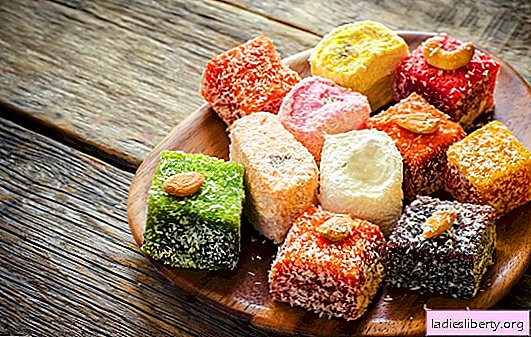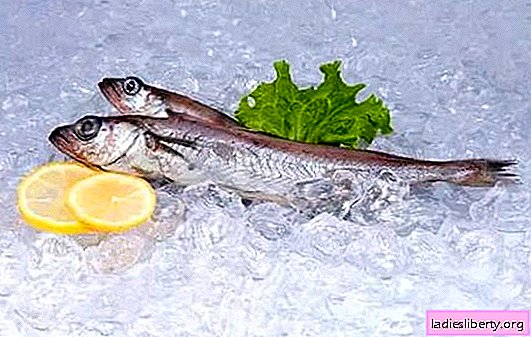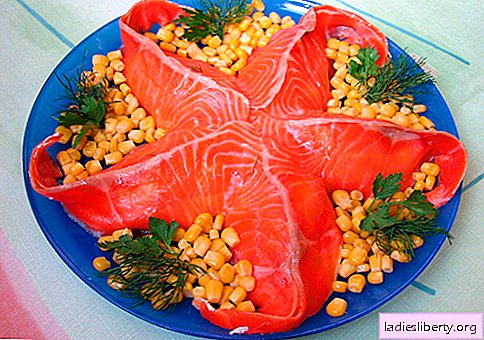
A very famous sweet not only in Syria and Turkey, but also in our area. What is the use of Rahat-lokum, and is there any harm from this treat?
Description and History
Turkish delight (or lokum) is a very famous and widespread delicacy. Literally translated from Turkish, it means "comfortable pieces." Turkish delight in Syria and Turkey is called only one of the varieties of Turkish delight, for the manufacture of which flour is used. But the shaker-lokum is called lokum, which is prepared without flour.
Most often in our market you can find Turkish delight in the form of small cubes, which are sprinkled with powdered sugar. They come in different shapes, tastes, colors, with various additives. But Turkish delight is considered a national sweetness not only in the eastern countries, but also in many others, for example, in Greece.
They say that roses were used to make the first Turkish delight, or rather, their petals around the 15th century. 500 years ago, this sweet was a delicacy that was intended only for the upper classes of people. Turkish delight in the form in which we know it now, began to be produced in the 18th century in Turkey. According to historical information, its founder is the court confectioner Ali Haji Bekir. He served under the Sultan of Turkey, who was very fond of sweets. At the end of the 19th century, at the world exhibition in Brussels, Turkish delight was submitted for a test, where the delicacy won first places. After this exhibition, sweets began to spread throughout Europe and other countries.
Details on the composition of Turkish delight
The energy value of the product per hundred grams:
● 0.8 grams of protein;
● 0.7 grams of fat;
● 79.4 grams of carbohydrates.
The calorie content of this sweet is 315 kcal per 100 grams of Turkish delight.
The usual (classic) version of Turkish delight consists of the following ingredients:
● any starch (potato, corn);
● sugar;
● icing sugar;
● water;
● nuts (or other fillers).
The calorific value of this product may vary based on how the ingredients are replaced, whether they are used in greater or lesser amounts, and which products are used additionally. Additional components may include:
● almonds;
● various juices;
● cognac;
● vanillin;
● flour;
● various berries;
● rice, and much more.
Turkish delight can be varied based on the shape of the product. There are such options:
1. In the form of cubes;
2. In the form of figures. These can be figures of animals, fruits, objects, and they are often intended for children;
3. In the form of a roll formation;
4. Whole Turkish delight;
5. Arabic. This kind is not cut into small cubes, but into large pieces in the form of a parallelepiped;
6. In two or more layers.
Turkish delight is also distinguished among themselves depending on the main ingredients that are used for the manufacture of:
1. Fruit. This type of Turkish delight implies that instead of sugar, fruit juice is used, which at the same time gives a rich color to the treat.
2. Walnut. Pistachios, peanuts, hazelnuts are the main nuts that are usually added during manufacture.
3. Floral. Turkish delight cubes contain flower petals (often roses), or the water infused on them.
4. Classic Turkish delight. This type eliminates any additional additives. It has a characteristic white color and consists of the main ingredients: granulated sugar, starch and water.
5. The vizier. To this day, it remains a gourmet sweetness and is often sprinkled with coconut.
6. Honey. For production, floral honey is used, which is added during cooking.
Today, there are much more types of Turkish delight with even greater diversity.
What is the use of Turkish delight
The benefit of Turkish delight is that it has a lot of glucose in its composition. It is this useful substance that improves the functioning of brain cells, as well as the cardiovascular system. In addition, this product is a source of energy that the muscles and brain need on a busy day. And when these two substances, such as glucose and starch, are combined, the body receives additional forces to fight viruses and infections.
The substances that are in this treat help prevent neurosis and depression, while improving a dull mood.
If you use Turkish delight daily in moderation, this will help to avoid various disorders with the gastrointestinal tract. Regular use improves the condition of the hair, skin, and the immune system.
Turkish delight brings benefits if it is made on a natural basis from natural ingredients (natural juice, nuts, honey). Then, those that are in the ingredients present can be prescribed for beneficial substances.
Does Turkish Delight Harm
The harm of Turkish delight is its high calorie content and high sugar content. In order not to harm your body, it is necessary to use this product in moderation. Eating Turkish delight is not recommended for people suffering from overweight, since eating any sweetness leads to the deposition of subcutaneous fat.
If you do not control the amount of goodies used, this will lead not only to weight gain, but also to disorders of the gastrointestinal tract and metabolic processes.
In addition, limiting the use of the product is necessary in order to reduce the risk of a disease such as diabetes. And for those who already have this ailment, it is strictly forbidden to eat Turkish delight due to the huge amount of sugar.
The presence of powdered sugar does not make this product beneficial for the body. Because of the contents, the teeth, or rather the integrity of their enamel, can be very affected. Powdered sugar is very damaging to its composition. In turn, this very often leads to the onset and development of caries.
Today it is very difficult to find Turkish delight, which is made entirely from natural ingredients. But it's worth it, because in the usual versions of domestic delicacies there are a lot of flavorings, dyes and chemical food additives. They, in turn, very negatively affect the state of the body as a whole, as well as individual organs of the gastrointestinal tract, skin and contribute to ulcer and cancerous formations.
How to cook a treat
To prepare Turkish delight at home you will need:
1. For syrup:
● 4 cup sugar;
● a glass of water;
● 0.5 tsp citric acid.
2. For pasta:
● a glass of starch;
● 3 glasses of water;
● 0.5 tsp citric acid;
3. Optional:
● 200 g of nuts;
● icing sugar and starch for sprinkling the product.
Nuts must be cleaned and roasted at high temperature for 10 minutes.
To make syrup, you must dissolve sugar in water by adding citric acid. It is necessary to cook on a small fire until caramel forms, which will harden in cold water.
To make a paste, you need to mix starch with water and add citric acid. It is necessary to cook on a small fire until the mass is thickened. Then add sugar syrup and cook for another 20 minutes on low heat, then add nuts.
The resulting consistency is laid out in a mold covered with cling film and left to cool for 6-8 hours. After that, cut into cubes and sprinkle with powdered sugar.











